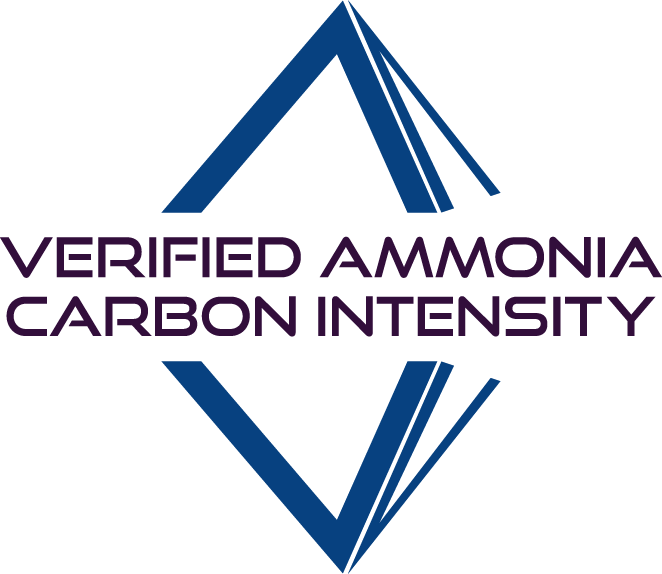ABOUT THE VERIFIED AMMONIA CARBON INTENSITY CERTIFICATION PROGRAM
Verified Ammonia Carbon Intensity is a voluntary certification of the carbon footprint of ammonia production at a specific facility from well to production gate.
The program utilizes a standard methodology developed by industry experts to calculate the carbon intensity of a facility’s ammonia production. The calculation is audited by a third party to both validate the data and verify the calculation. Once the auditor provides a written report confirming the carbon intensity was calculated by the facility according to the methodology, Verified Ammonia Carbon Intensity certifies the facility.
Built upon industry expertise, VACI was developed to increase transparency of the emissions related to the production of ammonia as well as the credibility of the calculation of carbon intensity.
Carbon intensity scores also enable the industry to move away from traditional colors associated with the different production methods of ammonia (gray, blue, green, etc.), for which carbon intensity scores may vary from facility to facility even with the same production method.
Safeguarding impartiality: Verified Ammonia Carbon Intensity is committed to impartiality and objectivity in every aspect of its operation and implements its policies and procedures fairly among all applicants, candidates, and certified companies.
WE ARE COMMITTED TO A PROCESS OF INTEGRITY AND TRANSPARENCY.
The Verified Ammonia Carbon Intensity certification program has opened a public consultation process for external stakeholders to provide feedback. We welcome industry and non-industry representatives, including ammonia consumers and other stakeholders, to provide feedback via this survey. Public consultation will be open for 60 days and will close on February 16, 2025.
If there is anything you can bring to our attention please submit an appeal or question here.
GENERAL FAQ
What is the certification measuring?
The inputs or emissions from the extraction of the raw materials up to the production gate of ammonia (well-to-gate) are accounted for in the carbon intensity calculation. Inputs include hydrogen; natural gas, RNG and RSG; electricity; and steam. Downstream emissions resulting from the transportation of ammonia may be optionally disclosed. Emissions from the construction of assets in the product system are excluded.
What does the Verified Ammonia Carbon Intensity program certify?
Verified Ammonia Carbon Intensity certifies an ammonia facility calculated the carbon intensity of ammonia production for a designated time frame (typically one year) in accordance with the program’s methodology, as validated or verified by a third-party auditor.
What standards are the program in compliance with?
VACI aligns with the following International Organization for Standardization/International Electrotechnical Commission standards:
- ISO/IEC 17065 conformity assessment, which sets forth requirements for entities engaged in certifying products, processes and services;
- ISO 14065, which provides general principles and requirements for bodies validating and verifying environmental information;
- ISO 14064, which provides guidance for the verification and validation of greenhouse gas statements; and
- ISO 14067, which provides requirements and guidelines for quantification of greenhouse gases for carbon footprint of products.
How is the Carbon Intensity calculated?
Methodology document can be found here.
What counts towards emissions reductions in the calculation of the Verified Ammonia Carbon Intensity?
Verified Ammonia Carbon Intensity allows for permanent sequestration or carbon capture for the use of Enhanced Oil Recovery. Utilization for the production of Urea or any other byproducts does not count towards emissions reductions in the Verified Ammonia Carbon Intensity.
How does the program avoid double counting?
Each ammonia producer that applies must have an internal company registry that is clearly defined to avoid double counting.
How does the program ensure the integrity of the results?
Verified Ammonia Carbon Intensity is committed to impartiality and objectivity in every aspect of its operation. Verified Ammonia Carbon Intensity implements its policies and procedures fairly among all applicants, candidates, and certified companies.
- Third-party auditors: independent auditing by qualified third parties ensures that the carbon intensity that is being certified meets the standard’s requirements and that the program’s methodology was properly applied.
- VACI-recognized auditors can be found here.
- Appeals and complaints: Please submit an appeal or complaint via the form above.
How does the certification benefit ammonia consumers?
Verified Ammonia Carbon Intensity provides ammonia consumers with greater transparency on carbon intensity so they can better understand what they are purchasing and the impact it is having on emissions, allowing them to confidently navigate the emerging low carbon ammonia industry.
Antitrust disclaimer: This program does not include the pricing of ammonia nor rate making practices and follows TFI’s antitrust guidelines.


